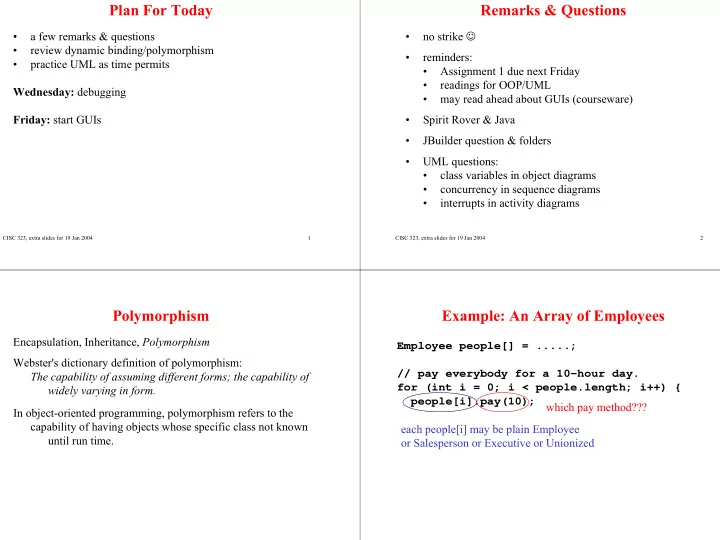

Plan For Today Remarks & Questions • a few remarks & questions • no strike ☺ • review dynamic binding/polymorphism • reminders: • practice UML as time permits • Assignment 1 due next Friday • readings for OOP/UML Wednesday: debugging • may read ahead about GUIs (courseware) Friday: start GUIs • Spirit Rover & Java • JBuilder question & folders • UML questions: • class variables in object diagrams • concurrency in sequence diagrams • interrupts in activity diagrams CISC 323, extra slides for 19 Jan 2004 1 CISC 323, extra slides for 19 Jan 2004 2 Polymorphism Example: An Array of Employees Encapsulation, Inheritance, Polymorphism Employee people[] = .....; Webster's dictionary definition of polymorphism: // pay everybody for a 10-hour day. The capability of assuming different forms; the capability of for (int i = 0; i < people.length; i++) { widely varying in form. people[i].pay(10); which pay method??? In object-oriented programming, polymorphism refers to the capability of having objects whose specific class not known each people[i] may be plain Employee until run time. or Salesperson or Executive or Unionized CISC 323, extra slides for 19 Jan 2004 3 CISC 323, extra slides for 19 Jan 2004 4
Example (2) Example (3) Employee people[] = .....; Employee people[] = .....; // pay everybody for a 10-hour day. // pay everybody for a 10-hour day. for (int i = 0; i < people.length; i++) { for (int i = 0; i < people.length; i++) { people[i].pay(10); people[i].pay(10); Solution: make the decision at run time based on actual type of At compile time: compiler doesn't know exact class of people[i] people[i]. Doesn't know which pay method to call Called dynamic binding . Compiler can't bind that call to an exact method CISC 323, extra slides for 19 Jan 2004 5 CISC 323, extra slides for 19 Jan 2004 6 How DoesThis Work? When Is Dynamic Binding Important? Inside each Java object is some identifying information – tells Whenever a child class has overridden a method of the parent, exact type of the object and the class of each object in the program is not obvious at compile time. john = new Employee("John", "programmer", 20); george = new Unionized("George", "electrician", 10); Dynamic binding involves overhead: space for extra information inside objects name: "John" name: "George" title: "programmer" title: "electrician" run time to decide which method to call wage: 20 wage: 10 payOwed: 0 payOwed: 0 Java class: Employee Java class: Unionized the Java compiler translates people[i].pay(10) into: look at the type of people[i] and call the appropriate pay method CISC 323, extra slides for 19 Jan 2004 7 CISC 323, extra slides for 19 Jan 2004 8
Note to C++ Programmers Exercise 1 In C++ and some other OO languages: class Cat { class Lion extends Cat { int data; public Lion(int d) { must specify which classes and methods need public Cat(int d) { super(d); data = d; } // end constructor dynamic binding ("virtual") } // end constructor public void identify() { public void identify() { System.out.println("lion " Big headache, causes bugs and confusion System.out.println("cat " + data); + data); } // end identify But saves overhead. } // end identify } // end class Lion } // end class Cat Java: All classes and methods use dynamic binding. // in another class: Cat pippi = new Cat(5); Exception: final classes and methods pippi.identify(); Lion simba = new Lion(8); simba.identify(); Cat elsa = new Lion(15); elsa.identify(); CISC 323, extra slides for 19 Jan 2004 9 CISC 323, extra slides for 19 Jan 2004 10 Exercise 2 Moral of Exercise 2 Dynamic binding happens for the implicit parameter only public class Exercise2 { static void show(Cat c) { (the object before the dot) System.out.println("cat with data = " + c.data); } // end show static void show(Lion ln) { someCat.identify() – dynamic binding (run time) System.out.println("lion with data = " + ln.data); } // end show show(someCat) – compile-time binding class Cat { public static void main(String[] s) { int data; Cat pippi = new Cat(5); public Cat(int d) { show(pippi); data = d; } // end constructor Lion simba = new Lion(8); } // end class Cat show(simba); Cat elsa = new Lion(15); class Lion extends Cat { show(elsa); public Lion(int d) { super(d); } // end main } // end constructor } // end class Lion } // end Exercise2 CISC 323, extra slides for 19 Jan 2004 11 CISC 323, extra slides for 19 Jan 2004 12
Exercise 3 Exercise 3, modified class Animal { class Cat extends Animal { class Animal { class Cat extends Animal { protected int data; public Cat(int x) { protected int data; public Cat(int x) { super(x); super(x); public Animal(int x) { } public Animal(int x) { } data=x; public int amethod(Cat c) { data=x; public int amethod(Animal a) { } return c.data-1; } return a.data+1; public int amethod(Animal a) { } public int amethod(Cat c) { } return a.data+1; } return c.data-1; } } } } } public class Exercise4 { public class Exercise3 { public static void main(String[] s) { public static void main(String[] s) { Cat garfield=new Cat(10); Animal snoopy=new Animal(1); System.out.println(garfield.amethod(garfield) ); Cat garfield=new Cat(10); } System.out.println(garfield.amethod(garfield) ); } System.out.println(snoopy.amethod(snoopy) ); System.out.println(snoopy.amethod(garfield) ); Exercise4.java:15: reference to amethod is ambiguous, both method amethod(Cat) in System.out.println(garfield.amethod(snoopy) ); Animal and method amethod(Animal) in Cat match } } CISC 323, extra slides for 19 Jan 2004 13 CISC 323, extra slides for 19 Jan 2004 14
Recommend
More recommend